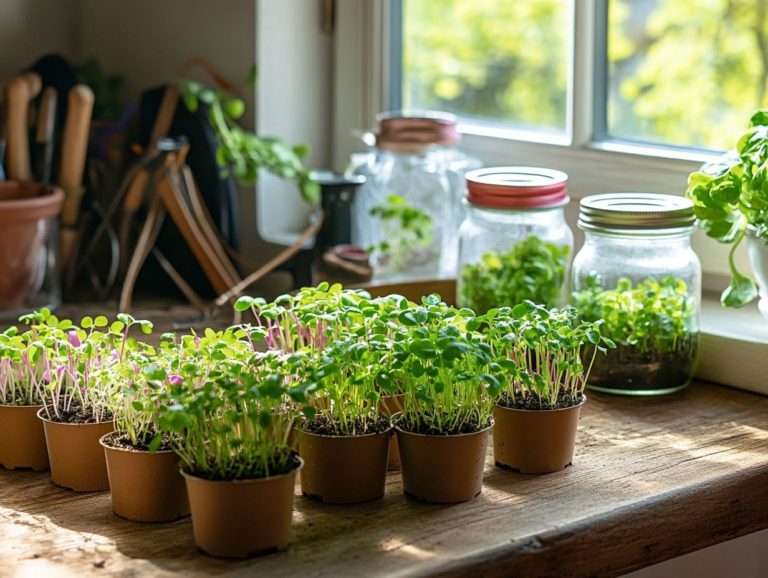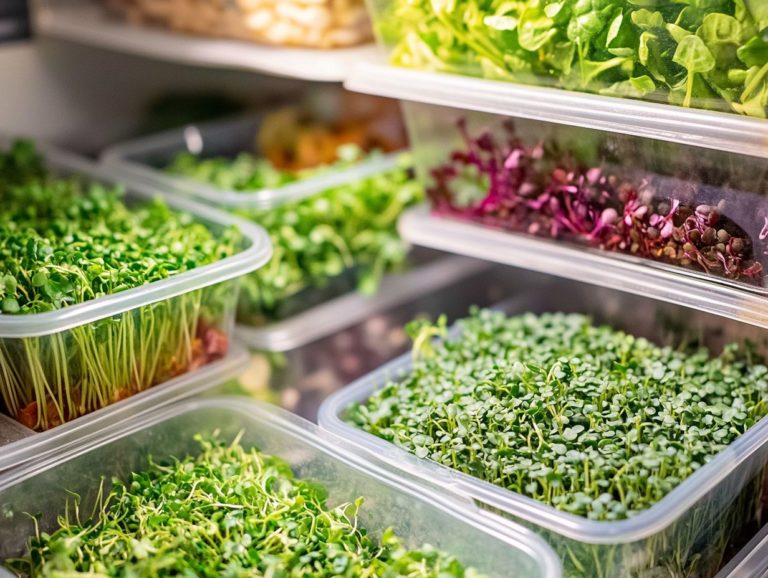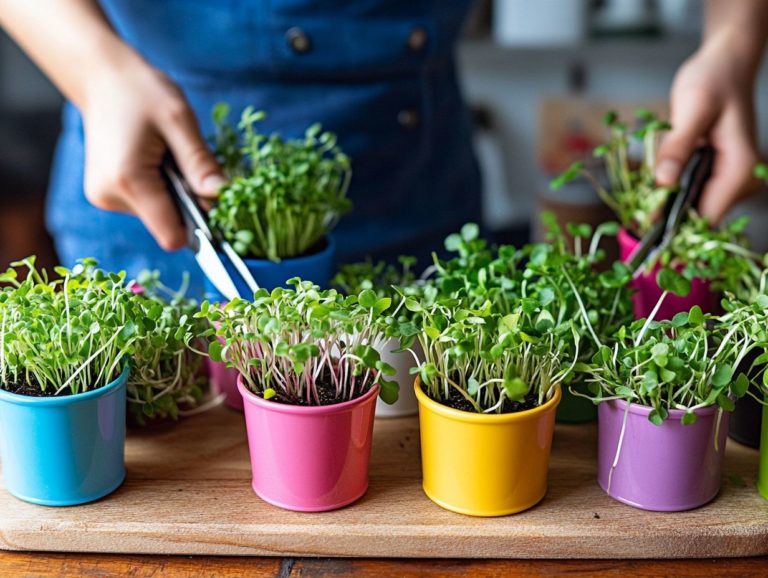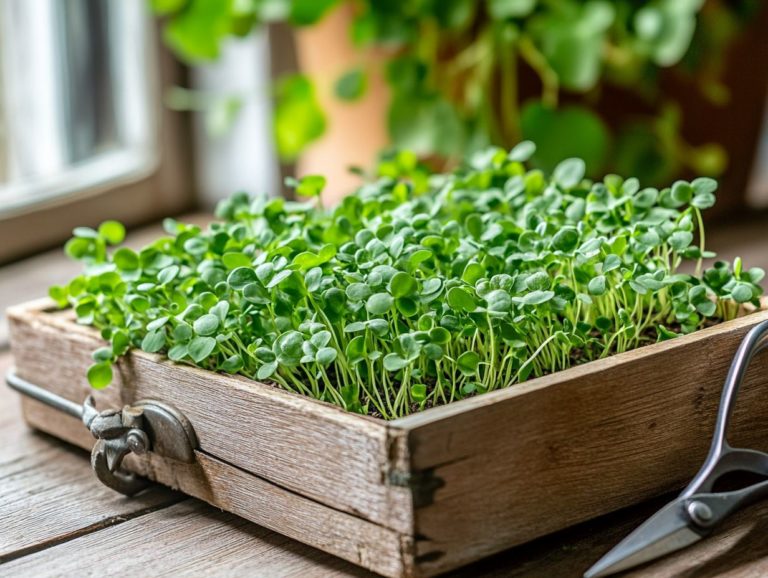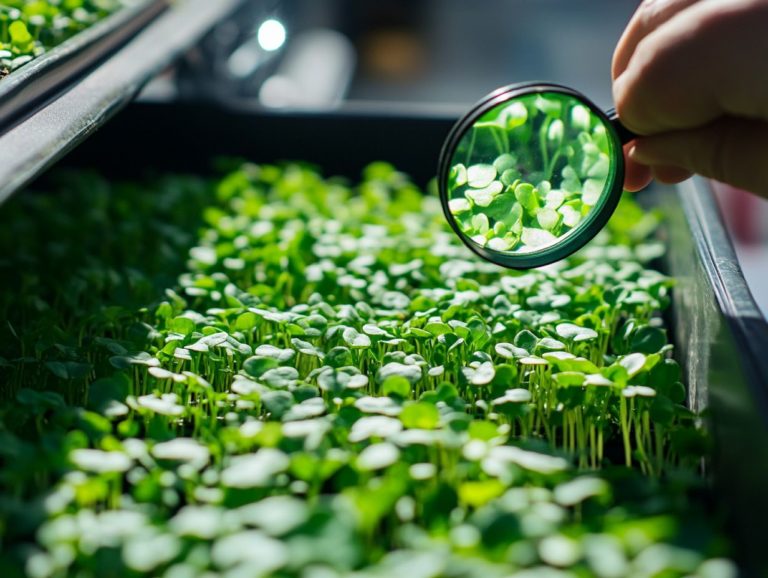Understanding Microgreen Post-Harvest Care
Microgreens are remarkable little powerhouses, bursting with flavor and nutrition that can elevate any dish while offering substantial health benefits.
In this article, you’ll explore what microgreens are, the diverse varieties available, and the incredible advantages they bring to your plate.
With an emphasis on post-harvest care, you’ll learn essential harvesting techniques, storage tips, and how to sidestep common pitfalls that can lead to spoilage. Discover best practices to keep your microgreens fresh and flavorful, ensuring they remain a vibrant addition to your meals.
Dive in to discover how to elevate your culinary experience to new heights!
Contents
- Key Takeaways:
- What Are Microgreens?
- Health Benefits
- Post-Harvest Care for Microgreens
- Common Mistakes in Microgreen Post-Harvest Care
- Tips for Successful Microgreen Post-Harvest Care
- Frequently Asked Questions
- What is the importance of understanding microgreen post-harvest care?
- What are the key elements of microgreen post-harvest care?
- How should I handle microgreens after harvesting?
- What is the best way to store microgreens after harvesting?
- Can I freeze microgreens for long-term storage?
- How can I tell if my microgreens have gone bad?
Key Takeaways:
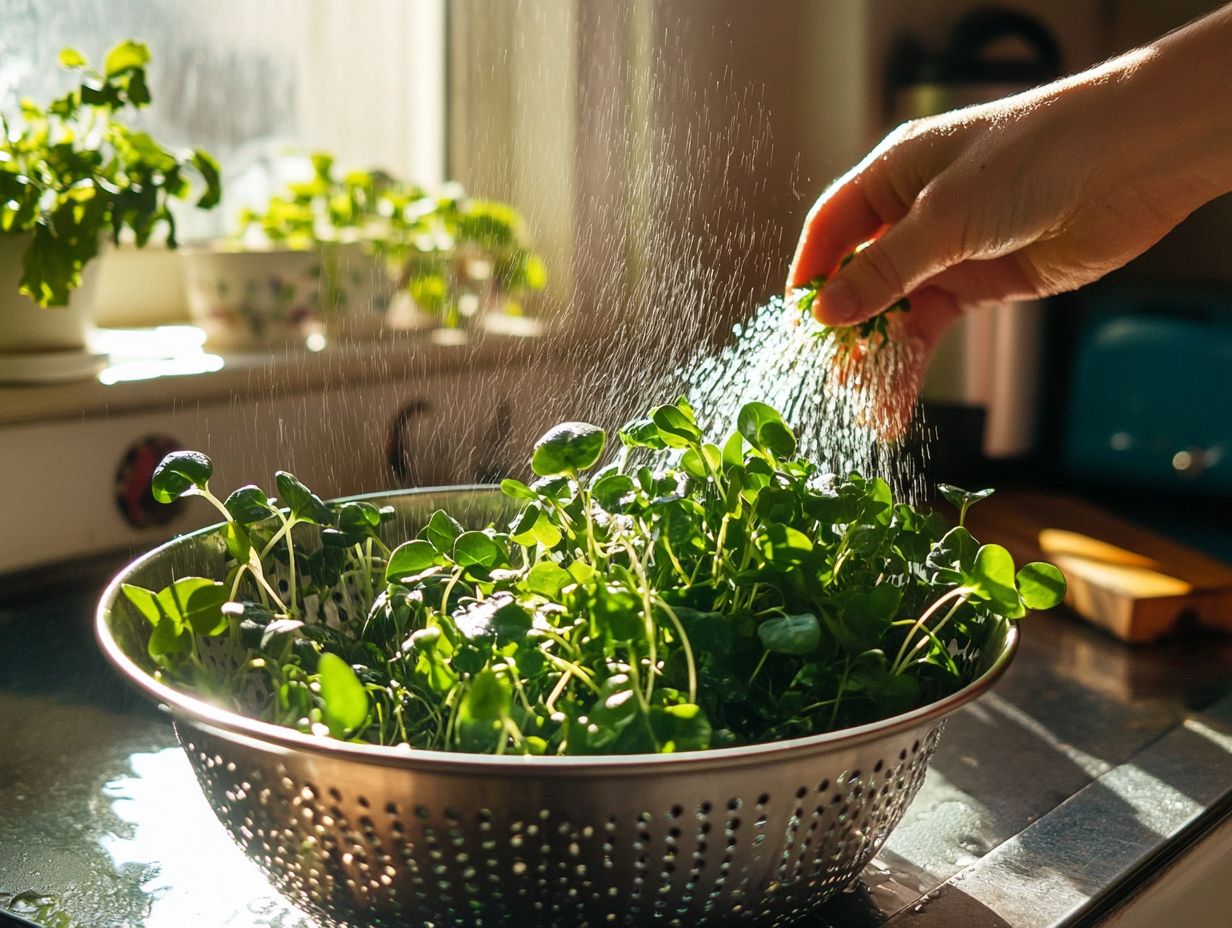
- Microgreens are young and tender edible plants that are packed with nutrients and can be easily grown at home.
- These tiny greens offer a wide range of health benefits and can be used in various dishes for added flavor and texture.
- To ensure the best quality and freshness, proper harvesting techniques, storage and preservation methods, and avoiding common mistakes are key in post-harvest care for microgreens.
What Are Microgreens?
Microgreens, those delightful little greens, are young, edible plants harvested at their tender early stage, usually just after the first true leaves, or cotyledons, have emerged. You ll find a fascinating array of flavors and textures, making them a favorite among home gardening aficionados and culinary experts alike.
Their vibrant colors, coupled with impressive nutrient density, mean that varieties like kale, arugula, and radish can elevate not only the nutritional value but also the visual allure of your dishes.
Microgreens encompass a delightful array of young, edible greens that you can harvest within 7 to 21 days after germination. Think of popular varieties like kale, arugula, radish, basil, and cilantro.
These tiny powerhouses are not just vibrant additions to your meals; they also bring diverse flavor profiles to the table. You’ll experience the peppery zing of arugula and radishes, juxtaposed with the sweet, aromatic notes of basil and cilantro.
Each type of microgreen thrives under different growing conditions. Some flourish in bright sunlight, while others prefer the comfort of partial shade. To ensure successful growth, it’s important to understand microgreen seed germination, making them perfect candidates for growing food in cities or your home gardening projects.
Beyond their delicious addition to your meals, microgreens are lauded for their impressive nutritional benefits. They often contain higher concentrations of vitamins and minerals compared to their mature counterparts. For example, red cabbage microgreens offer an exceptional antioxidant boost, setting them apart in terms of health benefits while adding a beautiful splash of color to any dish.
Health Benefits
The health benefits of microgreens are truly remarkable. These nutrient-dense little greens offer a higher concentration of vitamins and minerals compared to their mature counterparts, positioning them as a formidable ally in enhancing your immune system and overall well-being.
Rich in antioxidants, substances that protect your cells from damage, microgreens provide substantial amounts of essential nutrients like vitamins C, E, and K, along with iron, zinc, and magnesium all in just a small serving. Incorporating them into your diet can elevate your nutritional game significantly.
Nutritional Value and Culinary Uses
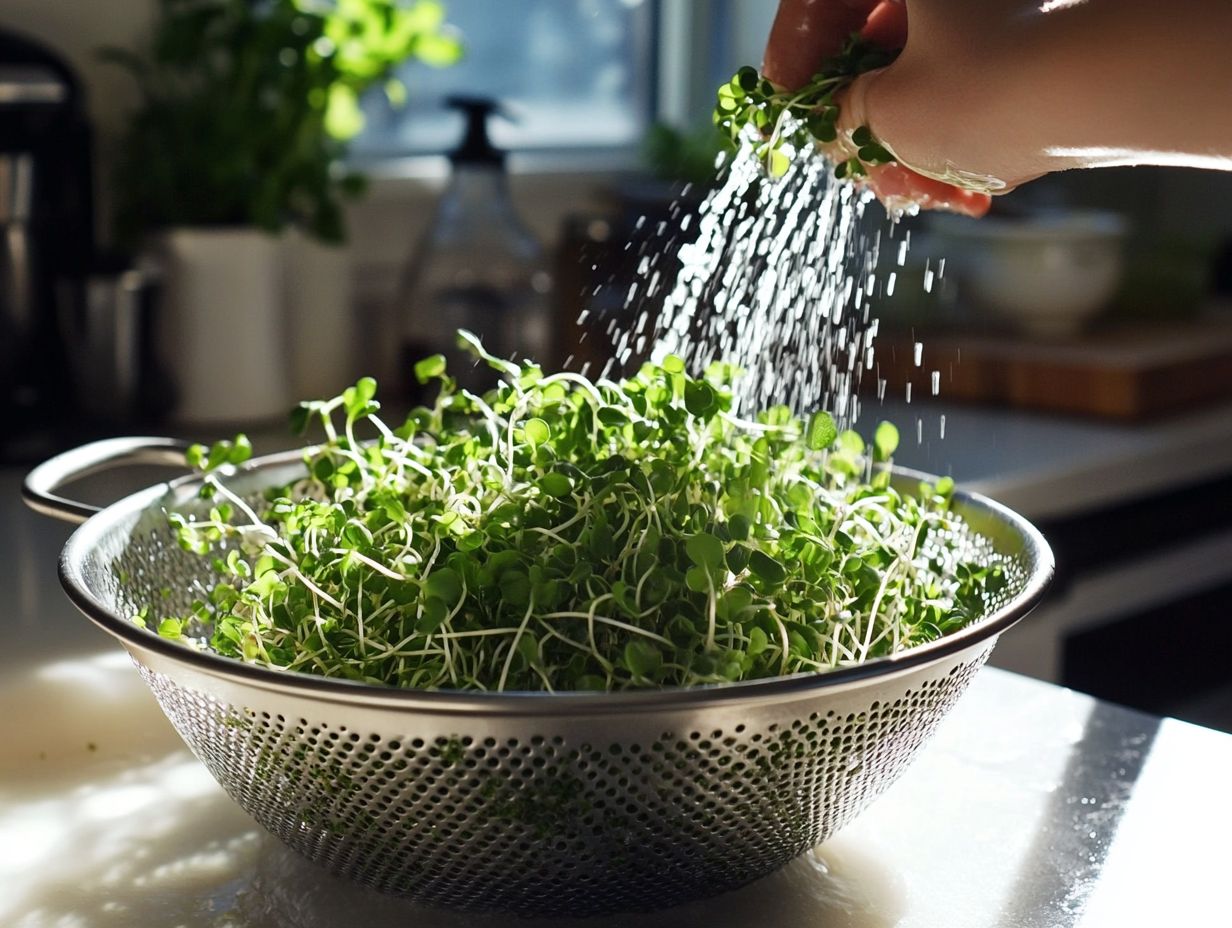
Microgreens aren’t just a feast for the eyes; they bring remarkable culinary versatility to your kitchen. With their vibrant flavors and impressive nutritional profiles, they’re loaded with essential vitamins and dietary fiber, a type of food that helps with digestion.
Imagine adding tiny greens like arugula, basil, or radish to your gourmet salads or artisanal sandwiches they transform these dishes into something extraordinary. A sprinkle on soups? That s your secret weapon for an added burst of freshness and complexity.
These little powerhouses not only elevate your meals but also come packed with essential nutrients. In fact, they boast higher concentrations of vitamins A, C, E, and K compared to their mature counterparts. To ensure you get the most from these greens, it’s important to know what is the shelf life of microgreens. Don’t miss out on these nutrient-packed greens! Incorporate microgreens today to boost your meals and health.
Post-Harvest Care for Microgreens
Post-harvest care for microgreens is essential to preserve their freshness, flavor, and nutritional value. After harvesting, handle them with care and use the right storage methods to prevent spoilage.
Prioritizing this step ensures that your microgreens remain at their best, ready to elevate any dish with their vibrant taste and health benefits.
Harvesting Techniques
Harvesting microgreens requires specific techniques to ensure the greens retain their quality and flavor. You’ll need sharp utensils and a keen sense of timing to cut them at just the right moment.
Microgreens are tiny powerhouses of nutrients, typically ready for harvest just after the first true leaves emerge. This usually happens within 7 to 21 days post-germination, depending on the variety. To enhance your experience, gather essential tools like clean scissors or a sharp knife, a brush for gently removing any soil residues, and containers to hold your freshly cut greens. For more insight, check out this guide on understanding the timing of microgreen harvest.
Don’t overlook the importance of high-quality potting and growing mediums; they provide the necessary nutrients and drainage that significantly enhance both flavor and longevity. A well-prepared growing environment supports healthy growth and contributes to a more vibrant and flavorful harvest.
Storage and Preservation
Proper storage and preservation of microgreens post-harvest are vital for extending their shelf life. Using clamshells, which are plastic containers that protect microgreens, is an effective strategy for keeping them fresh while preventing any damage.
To achieve the best results, create an environment that minimizes moisture loss. High humidity can lead to spoilage, while overly dry conditions may result in wilting. Various storage methods, such as refrigeration and controlled atmosphere storage, can help maintain the vibrancy of these delicate plants. After harvesting, it’s also important to know what to do with microgreens to ensure they stay fresh and delicious.
Clamshells not only offer protection but also create a semi-airtight seal, allowing for gentle airflow that reduces moisture buildup, thereby preserving the quality of your microgreens.
By mastering these storage techniques, you can enjoy the full nutritional benefits and freshness of your harvested greens.
Common Mistakes in Microgreen Post-Harvest Care
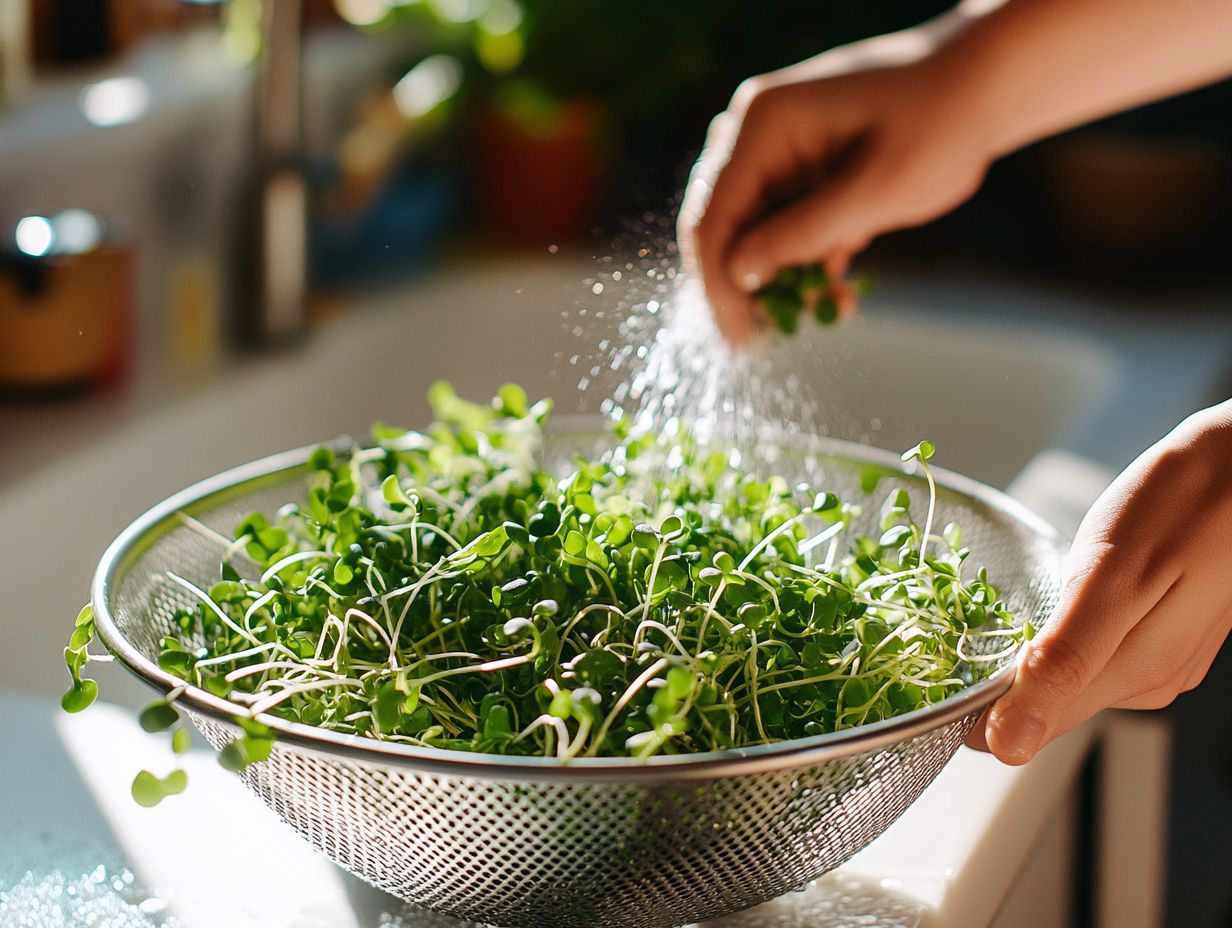
Inadequate attention to microgreen post-harvest care can lead to contamination and spoilage, ultimately undermining the health benefits and quality of these vibrant greens.
Handle this stage with care to keep your greens at their best!
Avoiding Contamination and Spoilage
Avoiding contamination and spoilage is essential for preserving the nutritional integrity and flavor of microgreens. This requires your utmost attention to cleanliness and storage practices.
When harvesting, use sanitized tools and gloves to prevent harmful bacteria. Work in a pristine environment, free from dust and pests, to protect the microgreens further. Once harvested, rinse them gently in cool water to eliminate any residual soil and impurities, then dry them thoroughly using a salad spinner or clean towels. Additionally, understanding watering techniques for thriving microgreens can enhance your harvesting process.
For storage, opt for breathable containers lined with paper towels to absorb excess moisture and minimize spoilage. Keeping them in a refrigerator at a stable temperature is key to maintaining their freshness and vibrant flavor. To further enhance your knowledge, consider learning about understanding microgreen shelf life. This allows you to savor the full benefits of these nutrient-dense greens.
Tips for Successful Microgreen Post-Harvest Care
By implementing effective tips for successful microgreen post-harvest care, you can significantly enhance the longevity and quality of your harvest. Start using these tips today to keep your microgreens fresh and nutritious!
Best Practices for Optimal Results
To achieve optimal results in microgreen post-harvest care, you ll want to focus on keeping things clean, storing them right, and eating them on time.
Start by ensuring a clean area during harvesting to prevent any germs from affecting their flavor and nutritional value. When handling these delicate greens, use careful washing methods to remove soil and debris without bruising them.
After cleaning, store your microgreens in a cool, dark place ideally wrapped in a damp paper towel and placed inside a bag that allows air to flow. This simple step can significantly extend their freshness.
Light can degrade important nutrients, so keep them in the dark during storage. By following these steps, you not only maintain the vibrant taste of your microgreens but also preserve their impressive health benefits. Enjoying them at their best allows you to reap the maximum nutritional rewards from these tiny powerhouses!
Frequently Asked Questions
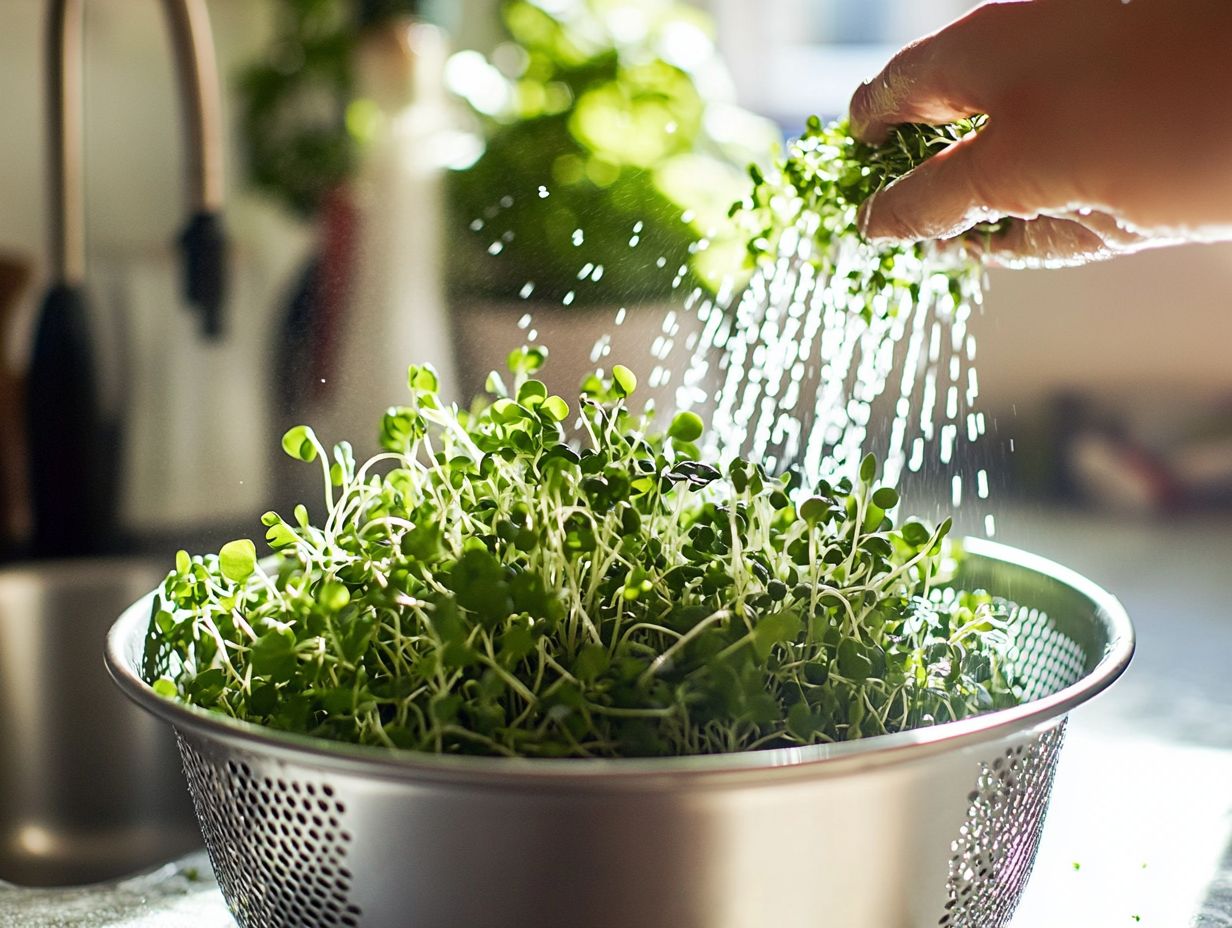
What is the importance of understanding microgreen post-harvest care?
Understanding microgreen post-harvest care is crucial in maintaining the quality and shelf life of your microgreens. Proper post-harvest care ensures that your microgreens stay fresh and retain their nutritional value, making them safe and healthy to consume.
What are the key elements of microgreen post-harvest care?
The key elements of microgreen post-harvest care include proper handling, storage, and packaging. These steps keep your microgreens fresh and tasty!
How should I handle microgreens after harvesting?
It is important to handle microgreens gently after harvesting to avoid damaging the delicate leaves. Use clean hands or gloves to avoid contamination and transfer them to a clean surface or container for further processing.
What is the best way to store microgreens after harvesting?
Microgreens should be stored in a cool and dark place, away from direct sunlight. They can be stored in airtight containers or plastic bags with paper towels or a damp cloth to maintain moisture levels. Consume them within a few days for optimal freshness!
Can I freeze microgreens for long-term storage?
Yes, microgreens can be frozen for long-term storage, but it is not recommended. Freezing can affect the texture and flavor of microgreens, making them less desirable. It is best to enjoy them fresh for maximum nutritional value.
How can I tell if my microgreens have gone bad?
Microgreens that have gone bad will have a slimy texture, a foul odor, and discoloration. If you notice any of these signs, it is best to discard them and use fresh ones. Always remember to inspect your microgreens before consuming them!

